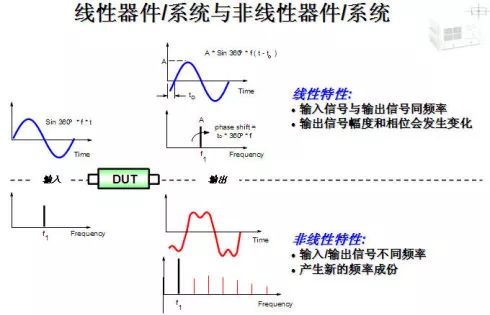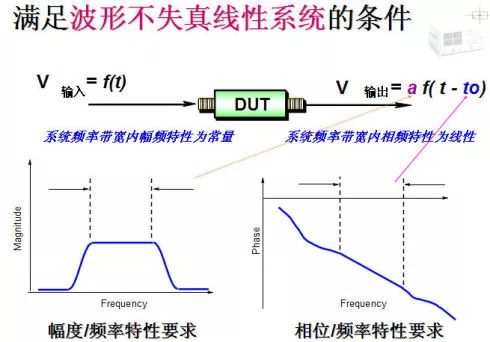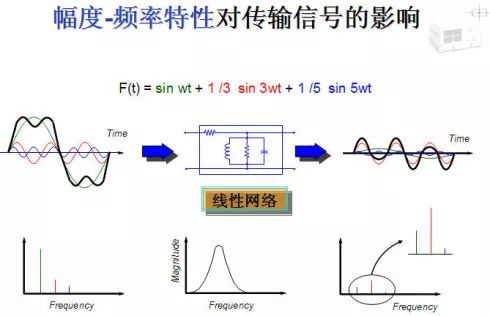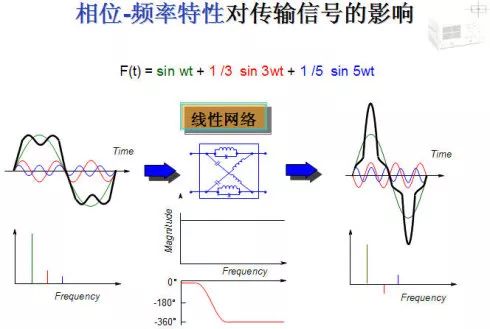Devices / systems with linear transmission characteristics produce only changes in the amplitude and phase of the input signal, but not new frequency components.
Non-linear devices / systems can shift the frequency of the input signal, or generate new frequency components, such as harmonics and intermodulation.
Many devices / systems that have linear characteristics under normal signal conditions may exhibit non-linearities, such as amplifiers entering the saturation region. This situation exists for passive devices (cables; filters) and active devices (amplifiers) of.

Figure 1 Linear and nonlinear characteristics
When used for system transmission signals, the transmission channel circuit should ensure that there is no distortion of the input signal waveform changes. Non-linear devices / systems will generate new frequency components that will definitely cause changes in the output signal waveform.
However, linear devices / systems will also change the waveform emission.
To meet the requirements for waveform distortion-free transmission, the device / system transmission characteristics must meet:
The amplitude / frequency characteristic should be kept constant within the operating frequency range, and the phase / frequency characteristic should remain linear within the operating frequency range.

Figure 2 Undistorted conditions of linear system
The following example can reflect the effect of the amplitude / frequency characteristics of the device / system on the transmitted signal.
In the example, the excitation input signal of the linear network is similar to a square wave waveform. The signal contains three frequency components in the frequency domain: fundamental wave; second harmonic; third harmonic. When the signal passes through the linear network, the amplitude / frequency characteristics of the linear network greatly attenuate the fundamental and third harmonics, causing the output signal spectrum to change. The corresponding time-domain waveform changes from a square wave to a sine-like waveform.
This is why there are strict requirements on the amplitude / frequency jitter of amplifiers, filters and other devices in the operating frequency band.

Figure 3 The effect of amplitude-frequency characteristics on the signal
Similar examples can reflect the effect of device / system phase / frequency characteristics on the transmitted signal waveform.
The signals transmitted in the actual work of the device / system are all modulated signals occupying a certain frequency bandwidth. If the phase / frequency characteristics of the device / system are not linear, the waveform of the modulated signal will change, causing signal distortion.

Figure 4 The effect of phase frequency characteristics on the signal
Compabile Models:
For Samsung:
For Galaxy S6, For Galaxy S6 Edge, For Galaxy S6 Edge+,
For Galaxy S6 Active, For Galaxy S6 Duos, For Galaxy Note Edge,
For Galaxy S7, For Galaxy S7 Edge, For Galaxy Note 5
For Galaxy S8, For Galaxy S8 Plus, For Galaxy Note 8
For Galaxy S9,For Galaxy S9 Plus
For Sony:
For Xperia Z4V, For Xperia Z3V
For Google:
For Nexus 4, For Nexus 5, For Nexus 6, For Nexus 7
For MOTORALA:
For Moto Droid Turbo, For Moto Droid Turbo 2, For Moto Droid 5
For NOKIA:
For Lumia 920, For Lumia 928, For Nokia Lumia 93, For Lumia 950, For Lumia 950 XL, For Lumia 1020, For Nokia Lumia 1050, For Nokia Lumia 822, For Nokia Lumia 735
For HTC:
For HTC ONE MAX T6, For HTC Incredible 4G, For HTC ONE mini 2, For HTC Droid DNA
For LG:
For LG Nexus 4, For LG Nexus 5, For LG G Pro, For LG D1L, For LG LTE2
For Iphone:
For Iphone8/X/XR/XS Max
For Others:
For YotaPhone 2, For Elephone P9000
Guangzhou HangDeng Tech Co. Ltd , http://www.hangdengtech.com
